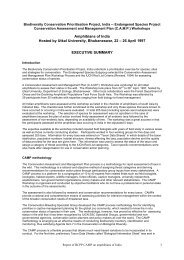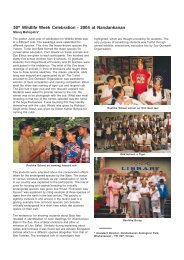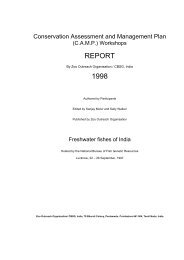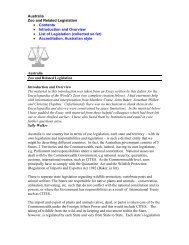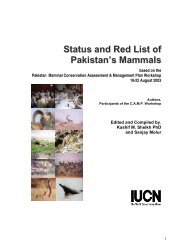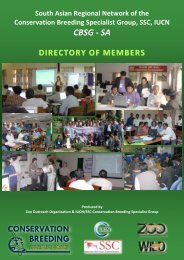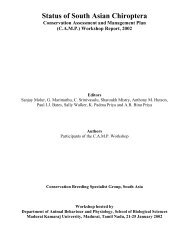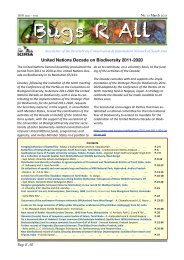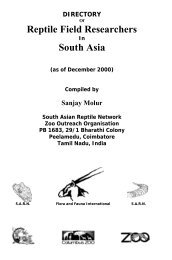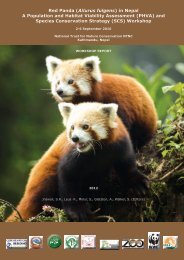IUCN Red List Categories and Criteria explained in brief below* IUCN Red List Categories :CR – Critically endangered -- a taxon is Critically endangered when it is facing an extremely high risk <strong>of</strong> extinction in the wildin the immediate future as defined by the criteria.EN – Endangered -- a taxon is Endangered when it is not Critically endangered but is facing a very high risk <strong>of</strong> extinction in thewild in the near future as defined by the criteria.VU – Vulnerable -- a taxon is Vulnerable when it is not Critically endangered or Endangered but is facing a high risk <strong>of</strong>extinction in the wild in the medium term future as defined by the criteria.LR – Lower risk – a taxon is Low Risk when it has been evaluated and does not qualify <strong>for</strong> any <strong>of</strong> the threatened categories,Critically endangered, Endangered, Vulnerable, or Data Deficient. (LR-nt – near threatened, LR-lc –least concern, LR-cd –conservation dependent.DD – Data deficient – A taxon is Data Deficient when there is inadequate in<strong>for</strong>mation to make a direct or indirect assessment<strong>of</strong> its risk <strong>of</strong> extinction based on its distribution and/or population status.NE – Not evaluated – A taxon is Not Evaluated when it has not yet been assessed against the criteria.** IUCN Red List CriteriaA – Population reduction – (1) observed, infered, suspected or estimated reduction, or (2) projected or predicted reduction <strong>of</strong>at least 20% (VU), or 50% (EN), or 80% (CR) in 10 years or 3 generations whichever is longer based on (a) Direct observation;(b) index <strong>of</strong> abundance appropriate <strong>for</strong> the taxon; (c) decline in areas <strong>of</strong> occupancy, extent <strong>of</strong> occurrence and/or quality <strong>of</strong>habitat; (d) actual or potential levels <strong>of</strong> exploitation; (e) effects <strong>of</strong> introduced taxa, hybridisation, pathogens, pollutants,competitors, or parasites.B – Restricted distribution -- Extent <strong>of</strong> occurrence estimated to be less than 20,000 sq km. (VU), or 5,000 sq km (EN) or 100sq km (CR) and/or area <strong>of</strong> occupancy estimated to be less than 2000 sq.km. (VU), or 500 sq km (EN), or 10 sq km (CR), andqualifying <strong>for</strong> any two <strong>of</strong> the following : (1) severely fragmented, or known to exist in not more than 10 locations (VU), or 5locations (EN), or single location (CR); (2) continuing decline, observed, inferred, projected in any (a) extent <strong>of</strong> occurance, (b)area <strong>of</strong> occupancy; (c) area, extent and/or quality <strong>of</strong> habitat; (d) number <strong>of</strong> locations or subpopulations; (e) number <strong>of</strong> matureindividuals; (3) extreme fluctuation in either (a) extent <strong>of</strong> occurance, (b) area <strong>of</strong> occupancy, (c) number <strong>of</strong> populations orsubpopulations, (d) number <strong>of</strong> mature individuals.C – Population estimates – population estimated to number less than 10,000 (VU), or 2,500 (EN), or 250 (CR) matureindividuals and either (1) estimated, continuing decline <strong>of</strong> at least 10% in 10 years or 3 generations or whichever is longer (VU),or 20% in 5 years or 2 generations, whichever is longer (EN), or 25% in 3 years or 1 generation whichever is longer (CR) OR in(2) continuing decline, observed, projected, inferred, number <strong>of</strong> mature individuals and population structure in the <strong>for</strong>m <strong>of</strong> either(a) severely fragmented [no subpopulation estimated to contain more than 1000 (VU), or 250 (EN), or 50 (CR) matureindividuals] ; (b) all individuals are in a single subpopulation.D – Restricted populations – (1) Population estimated to number less than 1000 (VU), or 250 (EN), or 50 (CR) matureindividuals; (2) Population restricted in area <strong>of</strong> occupancy <strong>of</strong> less than 100 sq km or less than 5 locations (VU).E – Probability <strong>of</strong> extinction – quantative analysis showing the probability <strong>of</strong> extinction in the wild is at least 10% in 100 years(VU), or 20% in 20 years or 5 generations, whichever is longer (EN), or 50% in 10 years or 3 generations, whichever is longer(CR).Summary Data Tables <strong>for</strong> Selected Species <strong>of</strong> Northern, Northeastern and Central <strong>India</strong>n Medicinal Plants are on thefollowing pages. Below is a Key to the symbols used in the tables :No. <strong>of</strong> Location : F = FragmentedRange:A = < 100 sq.km.; B = < 5,000 sq.km.; C= < 20,000 sq.km.; D= > 20,000 sq.km.;Area:A = < 10 sq.km.; B= < 500 sq.km.; C= 2,000 sq.km.;Data Quality: 1= Reliable census or population monitoring; 2 = General field studies; 3 = In<strong>for</strong>mal field sight-ings; 4 =Indirect in<strong>for</strong>mation; 5 Museum/ herbarium/ collection/ records; 6 = Hearsay/ popular.beliefThreat: Al = Artificial lighting; L = Loss <strong>of</strong> habiat; Lf = Loss <strong>of</strong> habitat due to fragmentation; D = Diseases; E =Edaphic factors (changes in); H = Harvest; Hf = Harvest <strong>for</strong> food; I = Human interference; P = Predation;Ps = Pesticides; Pu = Pollution; R = Road kills; Sf = Fire as catastrophic event; Sn = Siltation; T =Trade; Tp= Trade <strong>of</strong> partsResearch Recommendations: G= Genetic management; H=Husbandry research; Hm = Habitat maangement; Lh=Life history studies; Lm = Limiting factor management; Lr = Limiting factor research; M = Monitoring; O =Other (specific to the species); P = PHVA; PP = PHVA pending further work; S= Survey search and find; T= Taxonomic and morphological genetic stdies; Tl= TranslocationsCultivation Recommendations : 1= Captive breeding <strong>for</strong> conservation either only in in situ or both in situ and ex situwith the population maintaining 90% genetic diversity <strong>for</strong> 100 years; 2 = same as 1 but periodic rein<strong>for</strong>cement<strong>of</strong> captive stock with genetic materials from the wild; 3 = Captive breeding only <strong>for</strong> research,education or husbandry but not <strong>for</strong> conservation; 4 = Captive breeding <strong>for</strong> sustainable utilisation; 5 =restricted breeding; P = pendingLevel <strong>of</strong> difficulty: 1 = Least difficult; 2 = Moderately difficult; 3 = Very difficult; Unk = Unknown
* IUCN Red List Categories :IUCN Red List Categories and Criteria explained in brief belowCR – Critically endangered -- a taxon is Critically endangered when it is facing an extremely high risk <strong>of</strong> extinction in the wild in the immediate future as defined by the criteria.EN – Endangered -- a taxon is Endangered when it is not Critically endangered but is facing a very high risk <strong>of</strong> extinction in the wild in the near future as defined by the criteria.VU – Vulnerable -- a taxon is Vulnerable when it is not Critically endangered or Endangered but is facing a high risk <strong>of</strong> extinction in the wild in the medium term future as defined by the criteria.LR – Lower risk – a taxon is Low Risk when it has been evaluated and does not qualify <strong>for</strong> any <strong>of</strong> the threatened categories, Critically endangered, Endangered, Vulnerable, or Data Deficient. (LRnt– near threatened, LR-lc –least concern, LR-cd – conservation dependent.DD – Data deficient – A taxon is Data Deficient when there is inadequate in<strong>for</strong>mation to make a direct or indirect assessment <strong>of</strong> its risk <strong>of</strong> extinction based on its distribution and/or populationstatus.NE – Not evaluated – A taxon is Not Evaluated when it has not yet been assessed against the criteria.** IUCN Red List CriteriaA – Population reduction – (1) observed, infered, suspected or estimated reduction, or (2) projected or predicted reduction <strong>of</strong> at least 20% (VU), or 50% (EN), or 80% (CR) in 10 years or 3generations whichever is longer based on (a) Direct observation; (b) index <strong>of</strong> abundance appropriate <strong>for</strong> the taxon; (c) decline in areas <strong>of</strong> occupancy, extent <strong>of</strong> occurrence and/or quality <strong>of</strong> habitat;(d) actual or potential levels <strong>of</strong> exploitation; (e) effects <strong>of</strong> introduced taxa, hybridisation, pathogens, pollutants, competitors, or parasites.B – Restricted distribution -- Extent <strong>of</strong> occurrence estimated to be less than 20,000 sq km. (VU), or 5,000 sq km (EN) or 100 sq km (CR) and/or area <strong>of</strong> occupancy estimated to be less than 2000sq.km. (VU), or 500 sq km (EN), or 10 sq km (CR), and qualifying <strong>for</strong> any two <strong>of</strong> the following : (1) severely fragmented, or known to exist in not more than 10 locations (VU), or 5 locations (EN), orsingle location (CR); (2) continuing decline, observed, inferred, projected in any (a) extent <strong>of</strong> occurance, (b) area <strong>of</strong> occupancy; (c) area, extent and/or quality <strong>of</strong> habitat; (d) number <strong>of</strong> locations orsubpopulations; (e) number <strong>of</strong> mature individuals; (3) extreme fluctuation in either (a) extent <strong>of</strong> occurance, (b) area <strong>of</strong> occupancy, (c) number <strong>of</strong> populations or subpopulations, (d) number <strong>of</strong> matureindividuals.C – Population estimates – population estimated to number less than 10,000 (VU), or 2,500 (EN), or 250 (CR) mature individuals and either (1) estimated, continuing decline <strong>of</strong> at least 10% in 10years or 3 generations or whichever is longer (VU), or 20% in 5 years or 2 generations, whichever is longer (EN), or 25% in 3 years or 1 generation whichever is longer (CR) OR in (2) continuingdecline, observed, projected, inferred, number <strong>of</strong> mature individuals and population structure in the <strong>for</strong>m <strong>of</strong> either (a) severely fragmented [no subpopulation estimated to contain more than 1000(VU), or 250 (EN), or 50 (CR) mature individuals] ; (b) all individuals are in a single subpopulation.D – Restricted populations – (1) Population estimated to number less than 1000 (VU), or 250 (EN), or 50 (CR) mature individuals; (2) Population restricted in area <strong>of</strong> occupancy <strong>of</strong> less than 100sq km or less than 5 locations (VU).E – Probability <strong>of</strong> extinction – quantative analysis showing the probability <strong>of</strong> extinction in the wild is at least 10% in 100 years (VU), or 20% in 20 years or 5 generations, whichever is longer (EN),or 50% in 10 years or 3 generations, whichever is longer (CR).Summary Data Tables <strong>for</strong> Selected Species <strong>of</strong> Northern, Northeastern and Central <strong>India</strong>n Medicinal Plants are on the following pages. Below is a Key to the symbols used in the tables:No. <strong>of</strong> Location : F = FragmentedRange:A = < 100 sq.km.; B = < 5,000 sq.km.; C= < 20,000 sq.km.; D= > 20,000 sq.km.;Area:A = < 10 sq.km.; B= < 500 sq.km.; C= 2,000 sq.km.;Data Quality: 1= Reliable census or population monitoring; 2 = General field studies; 3 = In<strong>for</strong>mal field sightings; 4 = Indirect in<strong>for</strong>mation; 5 Museum/ herbarium/ collection/ records; 6 =Hearsay/ popular beliefThreat: Al = Artificial lighting; L = Loss <strong>of</strong> habiat; Lf = Loss <strong>of</strong> habitat due to fragmentation; D = Diseases; E = Edaphic factors (changes in); H = Harvest; Hf = Harvest <strong>for</strong> food; I =Human interference; P = Predation; Ps = Pesticides; Pu = Pollution; R = Road kills; Sf = Fire as catastrophic event; Sn = Siltation; T =Trade; Tp = Trade <strong>of</strong> partsResearch Recommendations: G = Genetic management; H = Husbandry research; Hm = Habitat maangement; Lh= Life history studies; Lm = Limiting factor management; Lr = Limitingfactor research; M = Monitoring; O = Other (specific to the species); P = PHVA; PP = PHVA pending further work; S= Survey search and find; T = Taxonomic and morphologicalgenetic studies; Tl = TranslocationsCultivation Recommendations : 1= Captive breeding <strong>for</strong> conservation either only in in situ or both in situ and ex situ with the population maintaining 90% genetic diversity <strong>for</strong> 100 years; 2 =same as 1 but periodic rein<strong>for</strong>cement <strong>of</strong> captive stock with genetic materials from the wild; 3= Captive breeding only <strong>for</strong> research, education or husbandry but not <strong>for</strong>conservation; 4 = Captive breeding <strong>for</strong> commerce; 5 = Restrictive breeding; P = PendingLevel <strong>of</strong> difficulty: 1 = Least difficult; 2 = Moderately difficult; 3 = Very difficult; Unk = Unknown
- Page 1 and 2: Biodiversity Conservation Prioritis
- Page 3 and 4: ContentsMammals of IndiaAuthors of
- Page 5 and 6: Ashra, Dr. N.V.K.Coimbatore Zoologi
- Page 7 and 8: Biodiversity Conservation Prioritis
- Page 9 and 10: Mammals of IndiaExecutive Summary
- Page 12 and 13: Vulnerable17 (31.5%)Status of India
- Page 14 and 15: Species Family IUCN CriteriaAlticol
- Page 16 and 17: Species Family IUCN CriteriaMacaca
- Page 18 and 19: Species Family IUCN CriteriaRattus
- Page 22 and 23: Mammals of IndiaSummary Data Table
- Page 24 and 25: Species Range Area No. ofloc./F%dec
- Page 26 and 27: Species Range Area No. ofloc./F%dec
- Page 28 and 29: Species Range Area No. ofloc./F%dec
- Page 30 and 31: Species Range Area No. ofloc./F%dec
- Page 32 and 33: Species Range Area No. ofloc./F%dec
- Page 34 and 35: Mammals of IndiaReport
- Page 36 and 37: IUCN Criteria for Endangerment used
- Page 38 and 39: In preparing for the workshop, a ma
- Page 40 and 41: exercises such as the Indian Red Da
- Page 42 and 43: SpeciesPrionailurus rubiginosus rub
- Page 44 and 45: SpeciesSuncus dayi *Suncus etruscus
- Page 46 and 47: Species IUCN Distribution in India
- Page 48 and 49: Species IUCN Distribution in India
- Page 50 and 51: Species IUCN Distribution in India
- Page 52 and 53: Species IUCN Distribution in India
- Page 54 and 55: ThreatsLoss of habitat and human in
- Page 56 and 57: Species Threats IUCNBiswamoyopterus
- Page 58 and 59: Species Threats IUCNCervus duvaucel
- Page 60 and 61: Species Threats IUCNMelogale person
- Page 62 and 63: Species Threats IUCNRattus sikkimen
- Page 64 and 65: Trade in non-threatened mammalsLoca
- Page 66 and 67: Research and management recommendat
- Page 68 and 69: scientific breeding technology with
- Page 70 and 71:
Table 6. Level of difficulty in bre
- Page 72 and 73:
Common name Scientific name IUCN No
- Page 74 and 75:
IUCN Red List Criteria Working Grou
- Page 76 and 77:
The workshop was a good exercise in
- Page 78 and 79:
DATA DEFICIENT (DD)A taxon is Data
- Page 80 and 81:
1. Level one recommendationA captiv
- Page 82 and 83:
TAXON DATA SHEETS1. Acinonyx jubatu
- Page 84 and 85:
morphological genetic studies; Surv
- Page 86 and 87:
Name of facilities: Refer Appendix.
- Page 88 and 89:
Occupied (Sq. Km): < 500. -Number o
- Page 90 and 91:
and temperate. Global Distribution:
- Page 92 and 93:
Area Occupied (Sq. Km): > 2,000. -N
- Page 94 and 95:
54. Chiropodomys gliroides (Blyth,
- Page 96 and 97:
Regional Distribution: Andaman & Ni
- Page 98 and 99:
Pradesh, Bihar, West Bengal, Assam.
- Page 100 and 101:
83. Elephas maximus Linnaeus, 1758
- Page 102 and 103:
population monitoring; General fiel
- Page 104 and 105:
to Bombay. -Elevation: Sea level-15
- Page 106 and 107:
(Namdapha). -Elevation: Up to 1000
- Page 108 and 109:
Appendix III. -IWPA (1972;91): Sche
- Page 110 and 111:
Sikkim. Threats: Not known. Trade:
- Page 112 and 113:
known. Other Comments: —. Status:
- Page 114 and 115:
difficulty: Not known. Exisiting Ca
- Page 116 and 117:
Not known. -No of Mature Individual
- Page 118 and 119:
Population: Not known. Regional Pop
- Page 120 and 121:
-Area Occupied (Sq. Km): > 2,000. -
- Page 122 and 123:
known. Data Quality: General field
- Page 124 and 125:
193. Murina grisea Peters, 1872 —
- Page 126 and 127:
Individuals: Not known. Global Popu
- Page 128 and 129:
Captive breeding: Pending. -Level o
- Page 130 and 131:
Asia. Current Regional Distribution
- Page 132 and 133:
Population: None in India . -Name o
- Page 134 and 135:
243. Ochotona nubrica Thomas, 1922
- Page 136 and 137:
fragmented location). -CITES: Appen
- Page 138 and 139:
No of Mature Individuals: Not known
- Page 140 and 141:
Sources (Refer Appendix): 20, 38, 2
- Page 142 and 143:
Collections). Recent Field Studies:
- Page 144 and 145:
occupancy and/or quality of habitat
- Page 146 and 147:
Population: None in India. -Name of
- Page 148 and 149:
ecord of breeding small mammals. -N
- Page 150 and 151:
None in India. -Name of facilities:
- Page 152 and 153:
in Tirunelveli; Bates et al., .1992
- Page 154 and 155:
iver side. Global Distribution: Nep
- Page 156 and 157:
Chakraborty & Pradhan in Western Gh
- Page 158 and 159:
in India. -Name of facilities: —.
- Page 160 and 161:
field study (A. Choudhury, 1986-89
- Page 162 and 163:
371. Vandeleuria oleracea (Bennett,
- Page 164 and 165:
SOURCESTaxon Data Sheets1. Abey (19
- Page 166 and 167:
77. Choudhury, A. U. (1997). The st
- Page 168 and 169:
164. Kumar, A. (1987) Ph.D thesis.
- Page 170 and 171:
240. Prakash, Ishwar (1995). J. Mam
- Page 172 and 173:
314. Suthakar Isaac, S. and Marimut
- Page 174 and 175:
Prani Sanghrahalay; 22. Aurangabad
- Page 176 and 177:
Corner; 20. V.O.C. Park Mini Zoo; 2
- Page 178 and 179:
Nandankanan Biological Park; 8. Mah
- Page 180 and 181:
Toronto zoo; 14. Yulee zoo; 15. Ban



